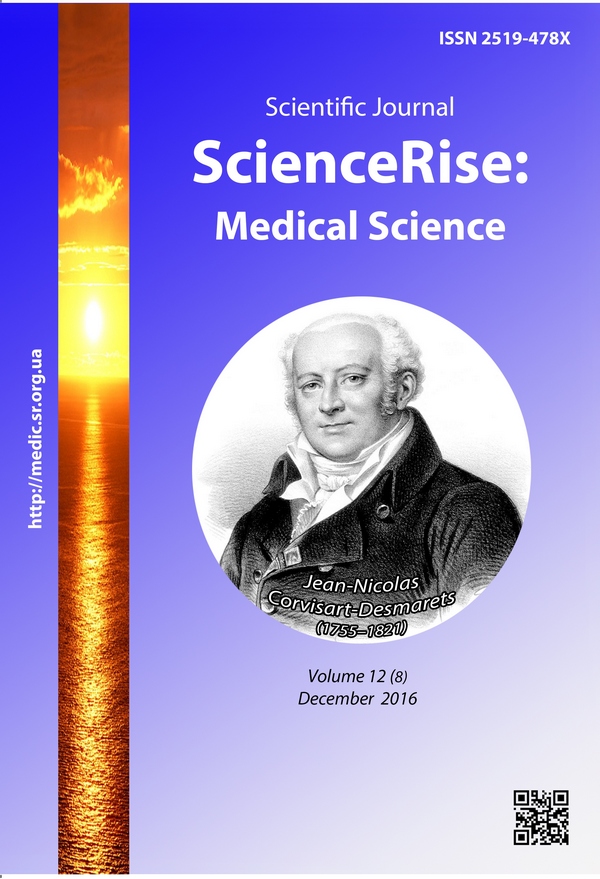Особливості соціального і родинного функціонування жінок, хворих на параноїдну шизофренію, з точки зору їх впливу на стан материнсько-дитячої взаємодії
DOI:
https://doi.org/10.15587/2519-4798.2016.86541Ключові слова:
параноїдна шизофренія, соціальне функціонування, родинне функціонування, мати, дитяче-материнські відносиниАнотація
З метою аналізу особливостей соціального і родинного функціонування жінок, хворих на ПШ з точки зору їх впливу на стан материнсько-дитячої взаємодії, обстежено 100 жінок, хворих на ПШ, та 112 їх дітей. Встановлено, що порушення материнсько-дитячої взаємодії у родинах, де мати хворіє на ПШ, виявляють тісний зв'язок з соціальною і родинною дисфункцією у матері, важкість яких визначає особливості психологічного стану дитини та викривлення її сприйняття сімейної ситуації та материнсько-дитячих стосунків
Посилання
- Maruta, N. A., Kozhina, A. M., Korostij, V. I., Gajchuk, L. M. (2011). Zhizn' s shizofreniej. Chto delat'? Kharkov, 25.
- Psihicheskoe zdorov'e: usilenie bor'by s psihicheskimi rasstrojstvami (2010). Informacionnyj bjulleten' Vsemirnoj organizacii zdravoohranenija, 220, 12.
- Jur'eva, L. N. (2010). Shizofrenija: klinicheskoe rukovodstvo dlja vrachej. Kyiv: Sfera, 24.
- Tandon, R., Keshavan, M. S., Nasrallah, H. A. (2008). Schizophrenia: Just the Facts What we know. Schizophrenia Research, 100 (1-3), 4–19. doi: 10.1016/j.schres.2008.01.022
- Jur'eva, N. M. (2014). Gendernospecifіchna dezadaptacіja socіal'nogo funkcіonuvannja u zhіnok, hvorih na paranoidnu shizofrenіju: analіz fenomenu ta osoblivostі terapіi і psihosocіal'noi reabіlіtacіi. Ukrains'kij vіsnik psihonevrologіi, 22/2 (79), 139–146.
- Kosenko, R. (2014). Features of psychopharmacotherapeutic and psychotherapeutic constituents in the complex treatment of women with paranoid schizophrenia at different models of family interaction. Journal of Health Sciences, 04 (06), 43–56.
- Morvaniuk, A. V. (2014). Analysis of the general approach to psychotherapy and pharmacotherapy schizophrenia with gender differences in ukraine and the world. Journal of Health Sciences, 04 (01), 339–348.
- Buzdigan, O. G. (2016). Diferencіjovanі pіdhodi do psihosocіal'noi reabіlіtacіi hvorih na shizofrenіju z urahuvannjam klіnіko-funkcіonal'nih gendernih osoblivostej. Ukrains'kij vіsnik psihonevrologіi, 24/4 (89), 47–53.
- Kosenko, K. A. (2015). Psihosocіal'na reabіlіtacіja zhіnok, hvorih na paranoidnu shizofrenіju, pri rіznih modeljah rodinnoi vzaemodіi. Kharkiv, 24.
- Zhivotovs'ka, L. V., Kazakov, O. A., Borisenko, V. V. (2015). Analіz sіmejnogo zdorov'ja pri shizofrenіi v odnogo z bat'kіv. Medichna psihologіja, 10 (3), 48–51.
- Pshuk, N. G., Markova, M. V., Pshuk, E. Ja. (2012). Dinamіka resursu sіm’i, de prozhivae hvorij na paranoidnu shizofrenіju. Ukrains'kij vіsnik psihonevrologіi, 20/3 (72), 215.
- Markova, M. V., Dіhtjar, V. O. (2012). Rіven' funkcіonuvannja rodini jak kriterіj viboru tipu psihoterapevtichnogo vtruchannja v kompleksnomu lіkuvannі hvorih na paranoidnu shizofrenіju. Ukrains'kij vіsnik psihonevrologіi, 20/2 (71), 56–57.
- Plevachuk, O. Ju. (2011). Vzaemozv’jazok perebіgu shizofrenіi z psihologіchnimi osoblivostjami mіkroseredovishha pacіenta. Kharkiv, 18.
- Markova, M. V., Dіhtjar, V. O. (2010). Osoblivostі sіmejnoi vzaemodіi ta adaptacіi v rodinі u pacіentіv, hvorih na shizofrenіju, z tochki zoru psihoterapevtichnogo potencіalu sіm’i. Ukrains'kij vіsnik psihonevrologіi, 13/3 (64), 133–134.
- WHO Psychiatric Disability Assessment Schedule (WHO/DAS) with a Guide to its Use (1988). Geneva: WHO, 96. Available at: http://apps.who.int/iris/bitstream/10665/40429/1/9241561114.pdf
- Abramov, V. A., Zhigulina, I. V., Rjapolova, T. L. (2009). Psihosocial'naja reabilitacija bol'nyh shizofreniej. Donetsk: Kashtan, 584.
- Lutova, N. B., Makarevich, O. V. (2011). Tipologija otnoshenija sem'i k terapii psihotropnymi preparatami. St. Petersburg, 19.
- Olіfіrovich, N. І., Zіnkevich-Kuzemkіna, T. A., Velenta, T. F. (2006). Psihologіja sіmejnih kriz. Sankt-Peterburg: Rech', 360.
- Lapach, S. N., Chubenko, A. V., Babich, P. N. (2001). Statisticheskie metody v mediko-biologicheskih issledovanijah s ispol'zovaniem Ecxel: Jeksperimental'nye issledovanija. Klinicheskie ispytanija. Analiz farmacevticheskogo rynka. Kyiv: Morion, 407.
##submission.downloads##
Опубліковано
Як цитувати
Номер
Розділ
Ліцензія
Авторське право (c) 2016 Майя Олександрівна Дрюченко

Ця робота ліцензується відповідно до Creative Commons Attribution 4.0 International License.
Наше видання використовує положення про авторські права Creative Commons CC BY для журналів відкритого доступу.
Автори, які публікуються у цьому журналі, погоджуються з наступними умовами:
1. Автори залишають за собою право на авторство своєї роботи та передають журналу право першої публікації цієї роботи на умовах ліцензії Creative Commons CC BY, котра дозволяє іншим особам вільно розповсюджувати опубліковану роботу з обов'язковим посиланням на авторів оригінальної роботи та першу публікацію роботи у цьому журналі.
2. Автори мають право укладати самостійні додаткові угоди щодо неексклюзивного розповсюдження роботи у тому вигляді, в якому вона була опублікована цим журналом (наприклад, розміщувати роботу в електронному сховищі установи або публікувати у складі монографії), за умови збереження посилання на першу публікацію роботи у цьому журналі.










